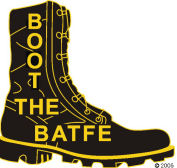

Arm the Afghan Women
![]()
By Wendy McElroy
It is commonplace to assume that toppling the Taliban will free Afghan women. But in an unstable country where soldiers celebrate conquest by raping — and where there is currently no guarantee that whatever form of government eventually assumes control will not be equally oppressive toward females — women have to protect themselves to remain free.
Afghan women need to exercise the right of self-defense, including gun ownership. They also need to be recognized as a force of armed resistance against oppressive regimes.
Freedom Fighters
In the 1970’s, Afghan women were among the most Westernized and liberated in the Islamic world. Their pre-Taliban role as doctors, bankers, lawyers, and teachers has been well documented. But almost no attention has been given to the part they played as freedom fighters against the Soviets, or to their potential for armed resistance against future oppressors who may again try to hijack the country as the new government takes form. Yet the evidence indicates that many Afghan women would fight to protect themselves and their families.
In October 1996, the New Internationalist magazine interviewed Nooria Jehan, a mother who joined the anti-Soviet mujahideen in guerilla warfare.
"I learned explosive techniques and began supervising and teaching the younger men," Nooria recalled. "We would stick explosives and detonators under the Russians’ tables and chairs."
When asked what she would do if the women-hating Taliban captured her city of residence, Kabul, Nooria said, "We will fight them as we fought the Russians."
That is what some women have done. In the Nov. 12 Newsday, journalists Matthew McAllester and Ilana Ozernoy quoted a woman named Malika, a mother whose family lived on the Taliban front line of Bagram just north of Kabul.
"At night I go up on the roof with my Kalashnikov [a Russian assault rifle] and my hand grenades to protect my house," Malika declared.
As the journalists commented, the very existence of Afghan women who take up arms suggests "a female population with more vitality and self-confidence than is immediately apparent."
Armed resistance is emerging as a sub-theme of women in Islam. The Iranian artist Shirin Neshat captured this in her acclaimed photographic series "Women of Allah (1993-97)." Neshat was born into Westernized Iran. Exiled during the Islamic Revolution, she returned to a nation in which women were silenced. From Neshat’s black-and-white photographs, women stare defiantly past their veils, some of them holding guns. The photographs challenge people to rethink their assumptions about the impotence of Muslim women. Women behind the veil have been underestimated.
Yet, their feminist champions in America depict these women as unmitigated victims who will not defend themselves. How can they ever be safe otherwise?
Self-Defense
The women of Afghanistan already know that the collapse of the Taliban will not remove their need for self-defense. In an appeal to the United Nations, the Revolutionary Association of the Women of Afghanistan (RAWA) openly referred to the Northern Alliance as "looters and rapists." RAWA called factions of the alliance "criminal and inhuman."
This is why feminists who champion Afghan women by dwelling exclusively upon their victimization and helplessness are doing them a disservice. It is the same feminist logic that cries out against rape while promoting gun control laws that would leave women defenseless. The opposite of victimization is empowerment.
Afghan women must be able to defend themselves if their rights are to be more than transitory. The solution may be as simple as the right to buy a gun. Weapons are easily available in that region. Women may need nothing more than the right to purchase a weapon — or the right to accept arms and earmarked donations from pro-gun organizations. Compassion for Afghan women and rage toward the Taliban is running so high that donations marked for "self-defense" might well flow in the same manner as donations for food and other relief — if such donations are permitted to do so.
Theresa Loar, president of Vital Voices Global Partnership, which promotes women’s global rights, declares, "If we are going to go in and rebuild Afghanistan and reverse the damage, we better not rely on the guys with the guns to make the decisions."
The best defense against "guys with guns" is women with guns. This is especially true if the woman is alone in her home, protecting her daughter from rape or her young son from being kidnapped into the military.
But feminists are not offering Afghan women this option. Eleanor Smeal, president of the left-wing Feminist Majority Foundation, urges instead that women play a key role in reconstituting Afghanistan’s future government. But history has shown us that this will not be enough. In 1964, Afghanistan adopted a constitution that included universal suffrage and equality for women. Women assumed roles in both the government and the judiciary, and constituted some 30 percent of Afghanistan’s civil service. But active participation in government didn’t prevent the Taliban from shrouding them in burqas. The ability to defend themselves might have.
Western forces cannot and should not patrol the streets of Afghanistan to prevent violence against women. If these women are to resume the Western advantages of having careers, freedom of speech and representation in government, they must also assume the responsibility of self-defense.
There is a saying: Give a man a fish, you feed him for a day. Teach a man to fish, you feed him for a lifetime. Give an Afghan woman the right to own a gun and you protect her long after the current tragedy has become old news. A gun in the hand of a mother who is protecting her child may be the most humanitarian relief of all.
![]()
Visit our article archive for more articles by Wendy McElroy
![]()
























